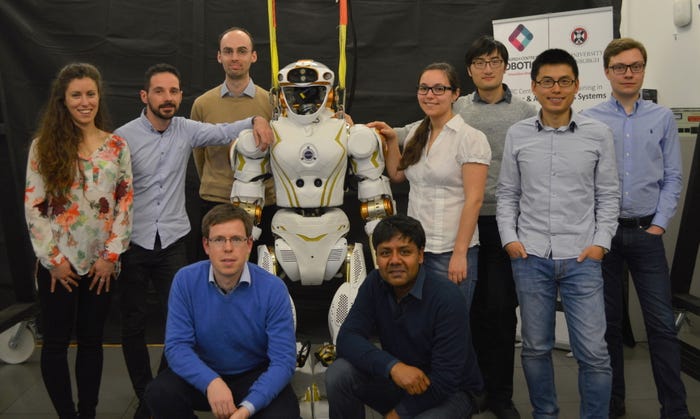NASA’s Valkyrie Robot Is Testing for Space Flight
National Robotics Week is a good time to check on the progress of Valkyrie, NASA’s humanoid robot, as she prepares for space missions.
April 11, 2024

At a Glance
- Android Valkyrie has been training for years to jump on a NASA space mission.
- Valkyrie is handy with space-based repair tools.
- She can help build moon-based housing and roads.
While humanoid robots were once viewed as cute-but-not essential machines, Valkyrie may change that view when she steps aboard a NASA space mission. Named after a Norse mythological woman who guides souls of the dead to the god Odin's hall Valhalla, Valkyrie has been gaining intelligence and dexterity as she prepares for missions.
I shook her hand once on a trip to NASA’s Johnson Space Center. That happened during her toddler years when she was shy and clumsy. Since then, she has grown up. She’s now six feet tall and weighs and weights 235 lbs. Valkyrie is an android with dexterous hands and advanced capabilities.
NASA scientists believe that with the right software, she will be able to function much like a human. She’s learning to expertly traverse uneven terrain, manipulate tools designed for humans, and assist astronauts on missions to the Moon, Mars, and beyond. And when she steps outside the spacecraft to fix a solar panel; she won’t need an awkward spacesuit.
Valkyrie is training for everything from fixing machinery on spacecraft to working on construction projects as NASA establishes permanent lunar bases. Valkyrie represents a new era where cyborg crews jointly expand human’s cosmic footprint. By testing applications in remote sectors like energy facilities, NASA scientists have been gathering data that can turn Valkyrie into an ultra-resilient robot.
Here's an example of using virtual reality to control Valkyrie's hands:
Valkyrie with her team during recent training in Australia:

Image courtesy of the University of Edinburgh.
Valkyrie's Physical Stats
NASA recently spelled out the details of Valkyrie’s capabilities on a limb-by-limb basis.
Power/Battery
Valkyrie can be configured to run from a wall or from battery power. The custom dual-voltage battery is capable of running the robot for about an hour. When a battery is not in use, it can be replaced with a mass simulator and capacitor that simulates the mechanical and some of the electrical properties of the battery.
Head/Sensor Suite
Valkyrie’s head sits atop a 3 DOF neck. The main perceptual sensor is the Carnegie Robotics Multisense SL, with modifications to allow for IR structured light point cloud generation in addition to the laser and passive stereo methods already implemented. Valkyrie also features fore and aft “hazard cameras” located in the torso.
Arms
Each upper arm consists of 4 series elastic rotary actuators and when combined with the forearm has 7 joints. The arm has a quick mechanical and electrical disconnect between the first two joints that allows for easy shipping and service.
Forearms/Hands
Valkyrie features a simplified humanoid hand, with 3 fingers and a thumb. Each forearm consists of a single rotary actuator (realizing the wrist roll), a pair of linear actuators (realizing wrist pitch and yaw), and 6 finger and thumb actuators. The hands are attached to the ends of the arms with mechanical and electrical quick disconnects that allow for easy shipping and service.
Torso/Pelvis
The robot’s torso houses two series elastic rotary actuators (the first arm joint on either side), two series elastic linear actuators that work in concert to realize motion between the torso and pelvis, and various computer and power facilities. The pelvis houses three series elastic rotary actuators: the waist rotation joint, and the hip rotation joint of each leg. The pelvis is considered the robot’s base frame, and includes two IMU’s.
Legs
Each upper leg contains five series elastic rotary actuators. The ankle is realized using two series elastic linear actuators working in concert. The leg has a quick mechanical and electrical disconnect between the first two joints that allows for easy shipping and service.
About the Author(s)
You May Also Like





